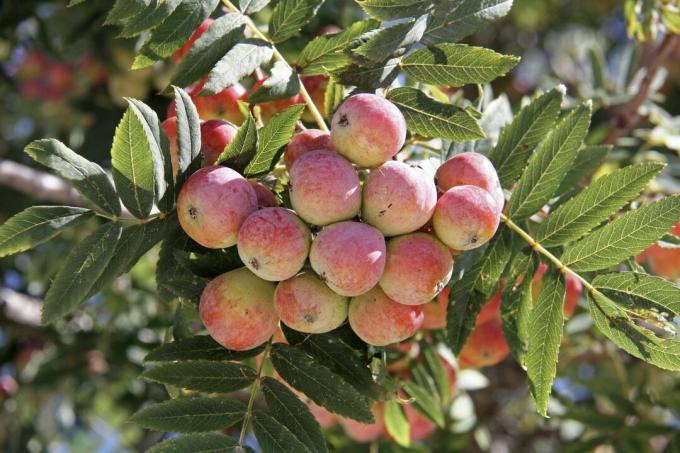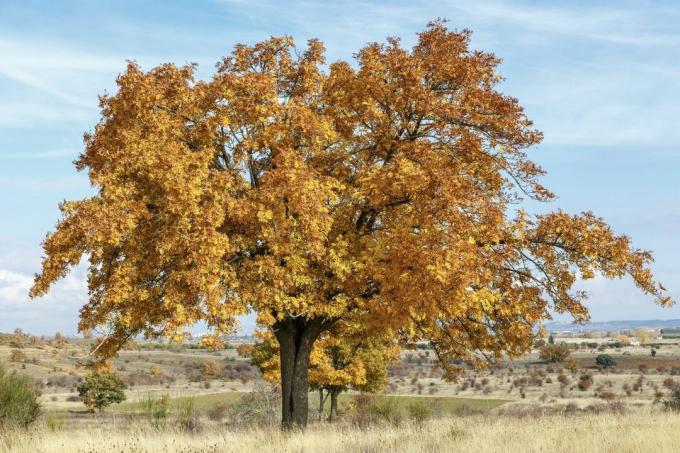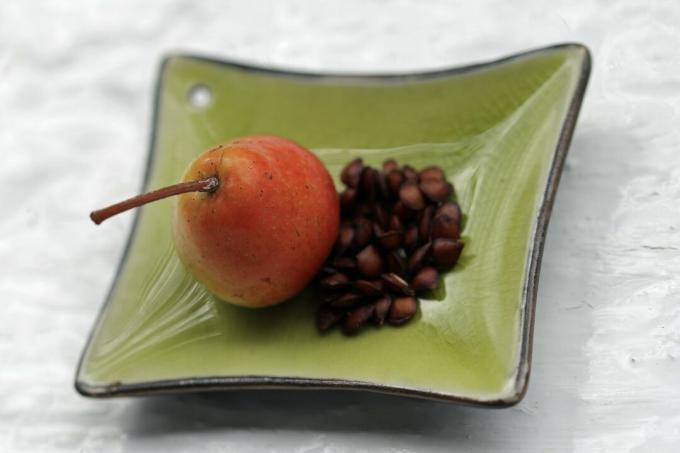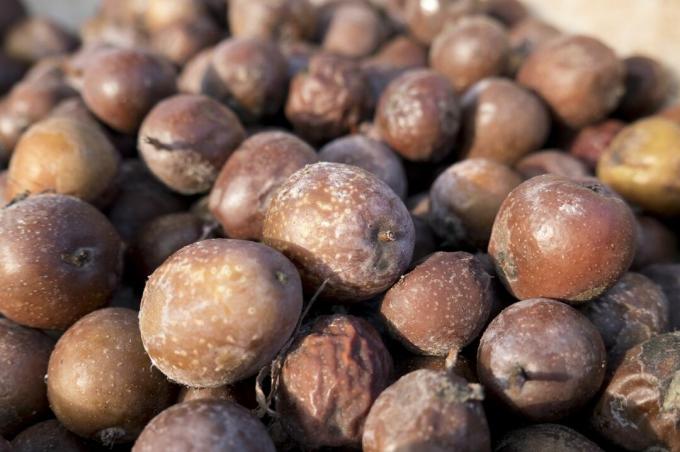In the past, the service tree was mainly planted in meadow orchards and was used to make must. In this profile you will learn everything about the characteristics, the requirements and the use of the service tree.

The service tree tree, which has become rare, provides valuable fruit for fruit connoisseurs. It is considered a climate change tree thanks to its tolerance to heat and drought. We introduce the service tree and give tips on planting and care.
"Contents"
- Service tree: origin and properties
- Service tree landraces at a glance
- Plant service tree: location, time and procedure
- Care of the service tree: cutting, watering and more.
- multiply service tree
- Harvesting and use of the service tree fruit
Service tree: origin and properties
service tree (Sorbus domestica), serviceberry (Sorbus torminalis) and rowan (Sorbus aucuparia) are closely related. All of these species belong to the Sorbus genus and are part of the large rose family (Rosaceae). The service tree is also known under the names Spierling, Sperberbaum, Butzelbeer, Schneebirne or Aeschrösle. It was originally distributed in Southern Europe, Asia Minor and the Caucasus as far as North Africa and reached Central Europe early on. Already in the 4th century B.C. Chr. the rare fruit tree was mentioned in writing by the Greeks. In addition, the service tree was a much-planted tree in medieval monastery gardens. Because of its love of warmth, the service tree is found in Germany mainly in southern, warmer areas and wine-growing locations, in the north up to the Harz foreland.
The slow-growing service tree is a medium-sized tree and grows to a height of 10 to 20 meters, in exceptional cases even 30 meters. Externally, it resembles the rowan berry in growth and foliage. The trunk is usually short, the crown is rounded and sprawling, and the tree becomes 10 to 15 meters wide with age. The bark is greyish-brown, scaly and looks like the pear (Pyrus communis) very similar. Hence the synonym Swiss pear tree. Service tree wood is the heaviest of all European deciduous trees, hard and strong, fine-grained and at the same time elastic. Due to its rarity, it has a high value and is mainly used for the production of veneers, but also for small furniture, turned work and works of art.
The leaf of the service tree consists of several leaves, is up to about 23 centimeters long and is imparipinnate. In autumn the foliage turns yellow to orange. The white flowers of the service tree sit in elongated panicles and provide plenty of food for pollinating insects from May to June.

The flowers develop into apple- to pear-shaped fruits, 2 to 4 centimeters in size, which are green-yellow and bright red on the sun-facing side. Like quinces, they have numerous hard stone cells that break down when fully ripe. For processing, the fruits are harvested from September, when they are tart and hard. As soon as the service tree fruits become overripe, soft and doughy, they can also be eaten raw. The taste of the Service Tree fruit is tart and sour and applesauce-like sweet. A single adult service tree can produce over 1000 kg of fruit in good years and often only 15 to 20 kg in bad years. Fully ripe service tree fruits are extremely tasty but very unsightly, brown and soft. Hence the trivial name "Drecksack".
Service tree landraces at a glance
Strictly speaking, there are no protected and registered varieties of service trees, but only selections based on accidental differences in fruit shape, color and other properties. These often regionally distributed selections are referred to as "country varieties" or "regional varieties". For example, there are local varieties with purely lemon-yellow or heavily brown rusty fruits. Alternatively, a distinction is made about the shape of the fruit, since many selections do not even have their own name: Sorbus domestica f. pomifera forms apple-shaped, Sorbus domestica f. pyriformis pear-shaped fruits, but there are also trees with both fruit shapes. We would therefore only like to present named selections.
- 'Bovender Nordlicht': Comparatively small service tree with early and regularly high fruiting. The pear-shaped fruits are bright red-yellow in color.
- 'Christophs Apfel': A small, apple-shaped selection up to about five meters in height suitable for commercial fruit growing.
- 'Sossenheimer Riese': Normal growth, high-yielding service tree with apple to pear-shaped, red-cheeked fruits. According to field tests by the State Institute for Viticulture and Horticulture (LWG) very well suited for fruit production.

Plant service tree: location, time and procedure
Service trees are extremely light and warmth-requiring plants. They cope very well with the temperature increase and drought caused by climate change and are therefore also planted as "trees of the future". The ideal location for Service Trees is sunny on dry to moderately fresh, well-drained, nutrient-rich and calcareous loamy soil.
Service trees are available in all common trunk diameters as half and standard trunks, as well as young plants that are only a few years old in most tree nurseries. However, when young they are at risk of frost at temperatures below -5 °C, are not competitive and tend to be slow-growing.
tip: Service trees do not tolerate transplanting very well, so container ware should always be chosen for them. Balled or bare-rooted plants are better only planted as 1-year-old plants, because older plants do not grow well. Care should be taken with grafted service trees (on mountain ash, hawthorn, medlar, quince or pear), the adhesions are often not stable and the plant is therefore usually short-lived.
Service Trees develop best in a solitary position with a planting distance of five meters on each side.
The best time to plant is in late autumn at the beginning of winter dormancy, from October to the end of November. Alternatively, you can plant before they sprout in March. Since the tree quickly loses more moisture through its leaves than the poorly grown ones To be able to acquire roots, small trees planted in the spring should first be watered regularly.
Planting the service tree: This is how it worksit
- Dig a large planting hole, about 1.5 times the size of the plant ball.
- Excavation with mainly organic long-term fertilizer, such as the Plantura organic universal fertilizer, touch up and mix.
- Put the root ball in the planting hole, fill it up with soil and compact it slightly.
- Attaching a tree tie: Drive in two pegs perpendicular to the wind direction and tie on the trumpet tree.
Care of the service tree: cutting, watering and more.
You don't have to cut the service tree regularly, as it doesn't tolerate it very well. Aged, dead and damaged branches should be pruned.
Diseases and pests mainly occur on sensitive, young and not yet well-established trees. In weakened plants, a heavy infestation of aphids can cause degeneration of shoot tips and leaves. On young service tree trees, scabs like Fusicladium orbiculatum and apple scab (Venturia inaequalis) appear. However, the greatest risk for young service trees is browsing by fallow and roe deer, which seem to love the taste of the leaves and shoots.
Frost-endangered young plants are provided with good winter protection in the first few years with jute, spruce or fir branches or fleece.
multiply service tree
Older trees will produce numerous root suckers that can be cut, dug up and transplanted. Service tree seeds must be cold treated (stratified) for generative propagation or sown outdoors through the natural winter in December to break their dormancy. the cold germinator need three months exposure to cold and should then be placed in a greenhouse at 20 °C or on a warm window sill for germination and kept well moist. Seed propagated Service Trees, however, need about 12 years until they flower and bear fruit for the first time. Alternatively, scion from adult trees can be grafted onto the seedlings, then the yield will start immediately.
tip: Seeds that result from the union of the genome of two different trees germinate much better than those that result from self-pollination. So if you want to harvest seeds, you should plant two different service tree trees or collect pollen elsewhere and transfer it by hand.

Harvesting and use of the service tree fruit
The service tree is harvested in September with the ripe, hard fruits ready for processing. These are either shaken from the tree or collected using a fruit picker. Hard, ripe fruits can be stored dry, cool and airy for 15 to 20 days, in some cases even up to 2 months. During this time, maturity develops. The unmistakable service tree schnapps "Sorbette" is made from it. To clarify and preserve apple juice, but also for the taste, you can add the fruit when juicing. With the help of the service tree, apple wine, cider or the service tree wine known in the Main area can be produced. Mixed with quince, apple or pears, you get a not too tart, tasty service tree jam. If you want to eat the fruit of the service tree raw, you should wait until it is brown and overripe, and feels soft and doughy. This usually happens between October and November.
Wild fruit is very much in vogue for a regional and conscious diet. Also the cornel (Cornus mas) presents us with numerous tasty fruits. We present the fruit tree in the profile.


